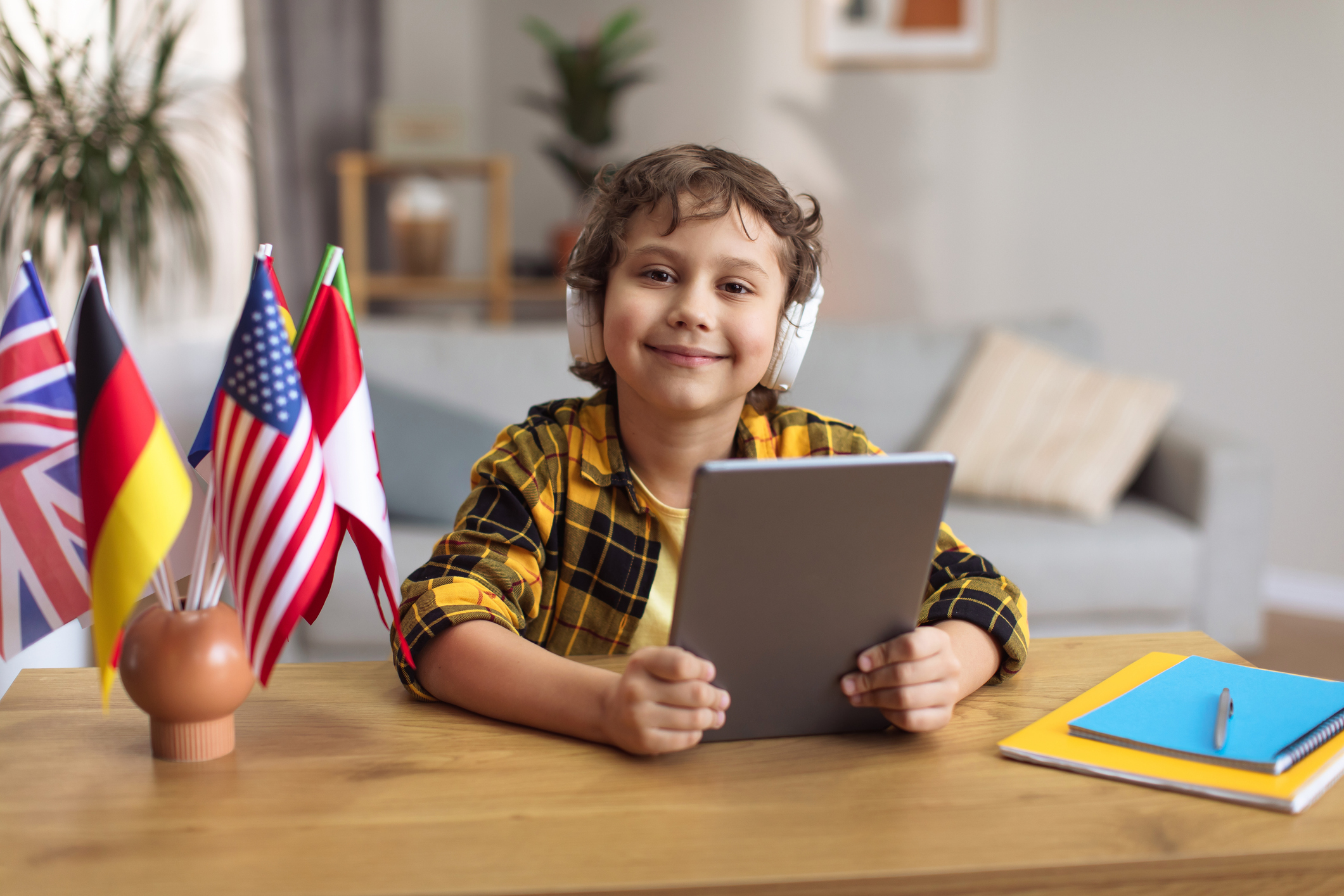9 Tips for Learning Spanish [Kids Edition!]



Want to help your child unlock the fastest way to learn Spanish? Well, you’re going to love the tips we share in this blog post!
As an online language school for kids, we know it’s hard to learn Spanish if the process lacks excitement and engagement.
That’s why these tips encompass everything from integrating play into study time to using proven techniques for memorizing new vocabulary quickly.
At the end of the post, we’ll also share information on how you can enroll your child in a free online Spanish class.
Let’s begin!
9 Spanish learning tips for kids
1. Don’t rely exclusively on Spanish language textbooks
While textbooks have their place, relying exclusively on them might limit kids’ overall language learning experience. To truly capture their interest, it’s crucial to diversify the resources used.
For example, you and your child explore Spanish children’s books, watch age-appropriate shows or cartoons in Spanish, and listen to Spanish music.
Authenticity is also key in second language acquisition, so consider incorporating resources created by and for Spanish-speaking communities.
For example, you can help your child practice reading and speaking using authentic menus from Spanish or Latin American restaurants.
This exposure to real-world language usage enhances their comprehension while instilling cultural nuances.
2. Have your child speak with native speakers ASAP
Encouraging your child to engage in conversations with native speakers from the early stages of learning Spanish is essential.
Even for beginners, speaking practice helps develop the confidence to overcome the fear often associated with speaking a new language. It also provides a real-world application of your child’s new language skills.
Of course, the initial hesitation to speak a new language is natural. However, by introducing conversations early on, you help your child build resilience and a positive attitude toward communication.
Consider organizing language exchange sessions, virtual or in-person, with native speakers or fellow learners. This practice should complement their study of grammar, vocabulary, and other language components.
3. Use spaced repetition to memorize vocabulary quickly
Spaced repetition is a game-changing technique for rapidly acquiring and retaining vocabulary. This method involves strategically spacing out the review of words over time, optimizing memory retention.
Parents can actively support their children in incorporating spaced repetition by first identifying the most frequently used Spanish words. By concentrating on high-frequency words, your child builds a strong foundation for effective communication.
Then, use flashcards or specialized spaced repetition language apps, such as Memrise, that tailor the review intervals based on each word’s difficulty.
Regularly revisit and quiz your child on these words, ensuring that the gaps between review sessions gradually increase as your child masters the words.
4. Record your child speaking Spanish
Recording your child speaking Spanish is a powerful strategy that serves dual purposes in their language-learning journey.
Firstly, recording allows them to practice without the immediate pressure of a live conversation. It creates a safe space for them to experiment with pronunciation, intonation, and sentence structure at their own pace.
Secondly, recording provides an invaluable means to document progress over time. By regularly capturing snippets of your child’s spoken Spanish, you create a tangible record of their linguistic development.
Reviewing these recordings with your child can also be a rewarding and encouraging experience, reinforcing their dedication to learning Spanish and boosting their overall language proficiency.
5. Learn Spanish alongside your child
Children often mirror their parents’ behavior, and seeing you actively engaged in learning can help reinforce the importance and excitement of acquiring a new language.
Collaborative activities like practicing conversations, playing language games, or even watching Spanish movies together can become enjoyable family rituals.
Learning together also facilitates a dynamic exchange of knowledge. Parents can provide guidance while children infuse the learning experience with fresh perspectives and curiosity.
6. Incorporate play into language study time
Injecting play into language study time can transform the learning process into an enjoyable experience. It also brings about numerous cognitive and emotional benefits for children learning Spanish!
Playful Spanish language activities engage multiple senses, making the learning process more memorable. Whether through language-themed board games, scavenger hunts, or interactive storytelling, children actively participate in the learning experience.
This hands-on approach provides a natural context for language use, encouraging spontaneous communication and creativity.
Additionally, incorporating play into language study time helps build a positive association with Spanish, preventing learning from feeling like a chore.
7. Schedule short study sessions every day
Opting for short, daily study sessions is a strategic approach that maximizes language learning efficiency, especially for children.
Unlike infrequent, longer study sessions, which may lead to burnout or disinterest, short daily sessions cater to a child’s attention span and energy levels.
Consistency is also key in language acquisition, and short, regular study sessions provide a structured routine that becomes a sustainable habit.
Short study sessions are also easier to incorporate into your child’s busy schedule, making it a feasible commitment for both parent and child.
8. Encourage your child to make mistakes
Encouraging your child to make mistakes is fundamental to a healthy language-learning mindset.
When children feel free to make errors without fear of judgment, it creates a supportive environment that promotes risk-taking and experimentation.
Like any language, Spanish involves a learning curve, and mistakes are stepping stones to improvement. They offer valuable insights into areas that require attention and refinement.
By normalizing mistakes, you can encourage your child to approach language learning with a positive attitude.
9. Enroll your child in Spanish classes for kids
Regular Spanish classes can provide a formalized learning environment that combines the expertise of certified instructors with the cultural authenticity of native speakers.
LingoCircle’s online Spanish classes for kids, tailored for ages 3-15, offer a comprehensive and engaging curriculum designed to meet young learners’ unique needs and interests.
We’ve designed our classes to be interactive and age-appropriate, incorporating games, storytelling, and interactive activities to make learning educational and enjoyable.
The online format also offers flexibility, allowing you to schedule classes around you and your child’s routines.
Get a free online Spanish class for kids
If you incorporate all nine tips for learning Spanish into your child’s routine, we know they can learn Spanish fast.
LingoCircle teachers can further enrich your child’s Spanish learning journey with personalized attention and a tailored curriculum!
So, why not try a free lesson?
Why choose LingoCircle
LingoCircle provides online Spanish classes for kids, featuring:
- Experienced teachers. Our team consists of experienced, passionate, native Spanish-speaking instructors specializing in online language teaching for children aged 3-15. They understand the unique needs of young learners, ensuring an engaging and effective language-learning experience.
- Interactive lessons. Using a variety of activities, games, and multimedia, our teachers keep children excited about learning Spanish. The interactive nature of our lessons ensures active participation, making language acquisition a dynamic and enjoyable process.
- Fun learning environment. Learning should be enjoyable, and that’s precisely what LingoCircle offers! Our classes create a supportive and fun environment where kids thrive alongside peers from around the world.
Ready to explore if online Spanish classes are suitable for your child? Click here to get your first class for free!


Simple Ways to Learn a Second Language at Home
Get resources and tips to help supplement your bilingual education journey at home.
By providing your email you are signing up to receive emails from Bilingual Bebe. Privacy Policy







